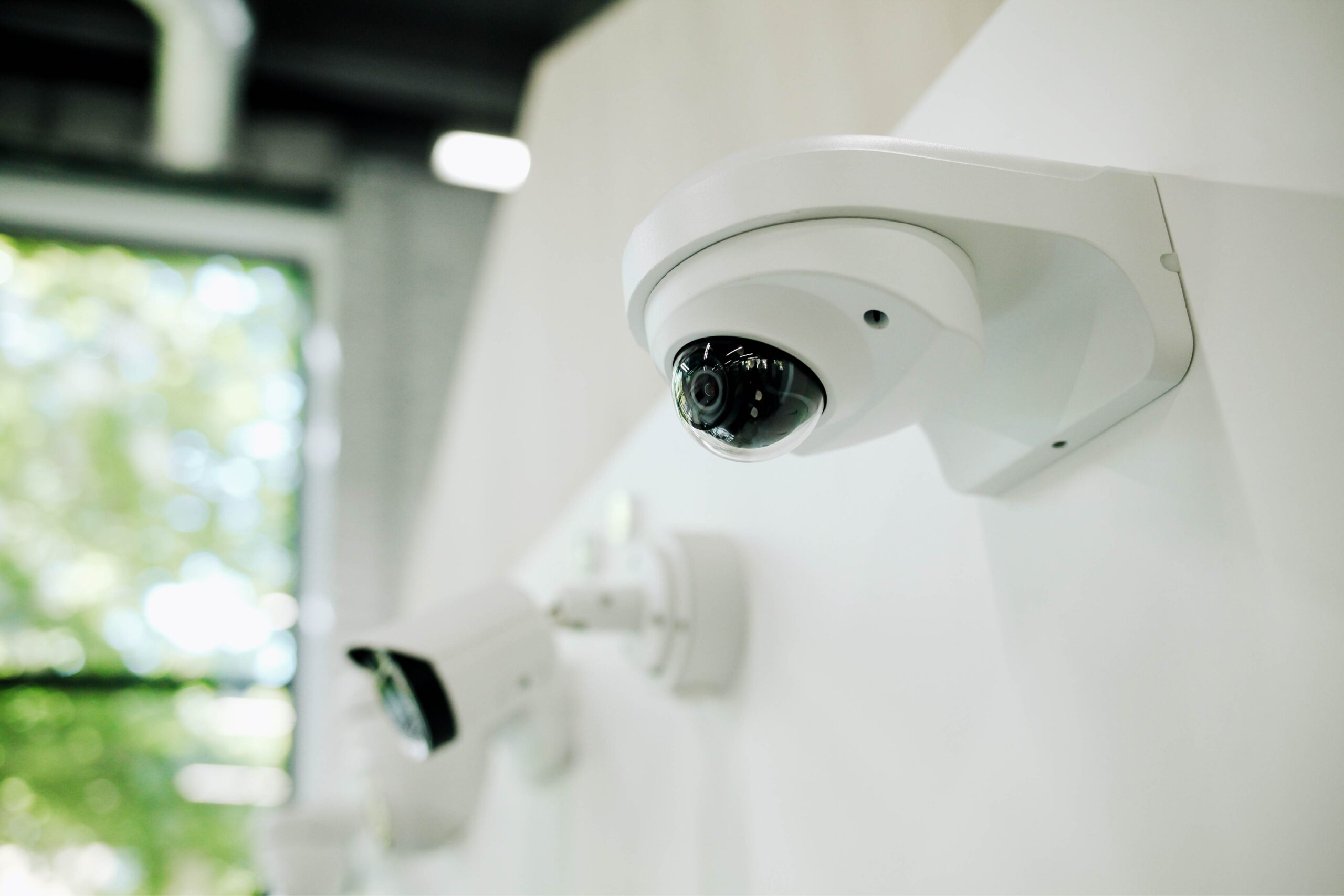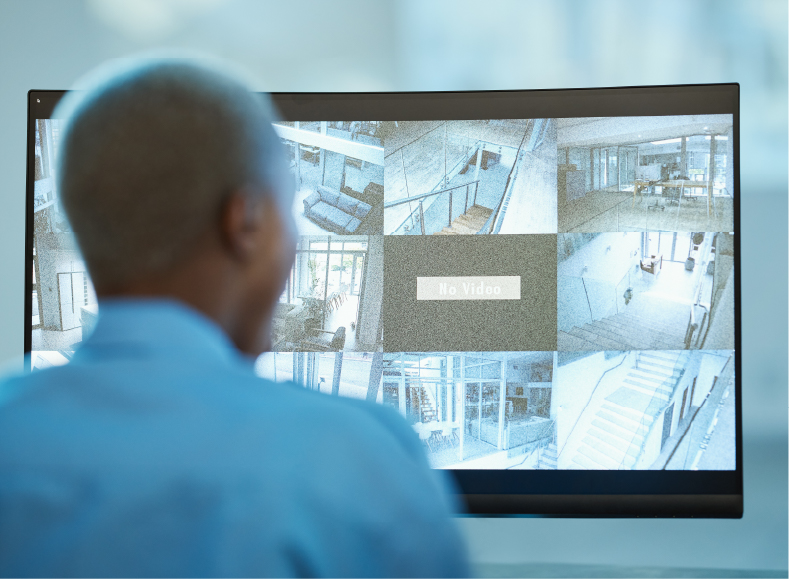
Choosing the Right CCTV System for Office Security: What Businesses Need to Know
Office buildings pose a variety of security challenges that businesses must address to safeguard their people, inventory, and property. CCTV security systems are designed to protect offices from many of these security threats, allowing companies to stay focused on their business growth instead of worrying about monitoring the building.
A closed-circuit television (CCTV) security system is a type of video surveillance used to monitor physical activity inside and outside a property. CCTV systems consist of cameras that record and transmit video footage over a closed circuit to a set of monitors and a storage device (or the cloud).
In this article, we’ll review CCTV systems and provide businesses with practical tips for how to choose a CCTV system that matches your needs.
What businesses should look for in a CCTV system
There are three important factors to consider when choosing a CCTV system for your business:
- Image quality
- Storage options
- Remote access
As this technology is continuously evolving, organizations must weigh the available options and decide whether they match your security needs today and tomorrow.
Here are important CCTV features you should look for:
Image quality: High-definition (HD) and 4K resolution
CCTV cameras equipped with high-quality image resolution ensure your footage is exceptional. HD cameras typically offer 1080p resolution for sharp footage that’s easy to store.
4K is a much higher resolution, designed for more detailed surveillance capabilities, such as license plate identification and facial recognition.
Storage options: Cloud, on-site, hybrid
Cloud-based storage offers scalability and remote access—that’s a good fit for businesses looking to avoid bulky hardware and the maintenance it requires. Cloud storage also acts as a backup, safeguarding against footage being damaged or tampered with on-site. A downside is that a spotty internet connection can make it difficult to access footage.
On-site storage implies footage is stored on an on-premise physical device like a digital video recorder (DVR). On-site storage is reliable because you can maintain system access and control regardless of internet connection. However, the flip side is that storage space can become an issue especially as higher-resolution image files take up more space.
A hybrid solution combines aspects of local and cloud storage capabilities. Benefits include an added layer of data protection and backup, plus maintaining a balance between on-site reliability and cloud scalability. Drawbacks include the complexity of managing a dual system and the potential costs involved.
Remote access and monitoring
Most modern CCTV systems come with remote access capabilities that allow business owners to view footage and manage settings via an app from a smartphone, tablet, or computer. With this app, you can monitor security from anywhere, at any time.
CCTV camera types and best use cases for office buildings
When weighing potential CCTV cameras for office buildings, it’s essential to understand the different types of cameras and their best use cases. Let’s dig deeper into key camera types, their advantages, and their ideal uses for office security.
What are essential CCTV security cameras options you should know?
Cameras work best when they are used as―and where―intended. There are several fundamental factors to keep in mind when choosing security cameras for your office:
-
Analog vs. IP
Analog cameras are physically connected to recording devices via coaxial transmission cables. They typically have lower image resolution and less storage capacity but are simpler and less expensive to install than digital options. They also aren’t dependent on internet connectivity.
IP, or internet protocol, cameras are a type of digital security camera that typically uses a Wi-Fi connection to transmit footage via an IP network. IP-based cameras offer more advanced features such as enhanced image quality, remote access, and scalability. However, they require a reliable internet network to function, can be more expensive to implement, and must be protected from cyberattacks.
-
Indoor vs. outdoor
Indoor cameras monitor controlled areas inside an office building such as hallways, lobbies, conference rooms, common areas, and others. They tend to be smaller and more visually discreet. Indoor cameras also have robust integration capabilities that sync with other security systems, such as access control and burglar alarms.
Outdoor cameras monitor exterior office spaces such as entrances, exits, parking lots, alleyways, and building perimeters. They can handle harsh outdoor conditions including rain, dust, and wind. They deter bad actors by design—outdoor cameras are visible and they are difficult to tamper with. Such cameras can include features such as night vision, wide field of view, floodlights, and audio sirens.
-
Wired vs. wireless
A wired network connects an IP camera to the network via an Ethernet cable. This setup is considered the most secure and efficient, but installation can be complex. Updating or making additions to this system might not be a simple task.
A wireless network, or Wi-Fi network, sends and receives data to a wireless modem. Installation, adjusting, and relocating aspects of the system (such as cameras) is easier, but reliance on a Wi-Fi network can lead to connectivity issues. It also raises cybersecurity concerns.
Bullet vs. dome cameras: Which is better for office security?
Bullet cameras are known for their long cylindrical shape, making them easy to spot while offering long-distance video coverage.
Pros:
-
- Good for long-range viewing
- Easy to mount and adjust
- Highly visible for crime deterrence
- Weatherproof and water-resistant
Cons:
-
- Susceptible to physical tampering
Best for: Surveillance of large outdoor areas including parking lots, building perimeters, and construction sites.
Dome cameras feature a circular design that encases the camera in a protective dome that safeguards against the elements and tampering.
Pros:
-
- Smaller and more discreet design for less obvious display
- Typically offer a wider field of view for broader visual coverage
- Extremely durable
Cons:
-
- Difficult to reposition once installed
- Not ideal for far-range or detailed surveillance
Best for: Indoor and outdoor spaces that require a wider field of view, including high-traffic reception areas, entryways, and garages.
Where to install CCTV cameras for maximum office security
Camera placement can make or break a security system. Poor video coverage can result in blind spots that prevent your business from being as secure and successful as it should be.
Don’t forget about these key areas when installing CCTV cameras:

- Front and back entrances: This ensures you can monitor all the foot traffic in and out of your office, and review video footage in the event of a security incident of any kind.
- Elevators: Elevator safety is important not only because it helps you keep track of who is traveling throughout the building, but in the event of a stuck or broken-down elevator you’ll be able to closely monitor the situation and respond appropriately.
- Parking lots: Protecting your staff shouldn’t stop at the entryway. Vandalism and theft are common occurrences in parking lots, as people and parked cars can be targeted, especially at night. If your business has a parking lot, you should strongly consider adding surveillance cameras there.
- Storage/stock rooms: Protecting valuable property and inventory is easier with video coverage of the rooms that the property is in. This helps deter not only trespassers but any staff who might try and take advantage of an opportunity.
- Offices: Cameras give staff peace of mind knowing there’s protection in the form of video cameras. This is also an insurance that recorded footage is available for analysis in the event of a break-in.
- Secluded areas: It’s important to be aware of secluded or hidden spaces where an individual can avoid detection. Do a thorough walk-through of your space to pinpoint these less obvious areas, and make sure you have a security plan that keeps them safe.
- Building perimeter: A strong security system should be comprehensive. If your interior is safe but your perimeter, parking lot, or garage are unmonitored, your staff and property aren’t fully protected. Establishing a camera presence for your building’s perimeter is a crucial aspect of a strong security operation.
CCTV integration with office security systems
The evolution of security technology has brought new possibilities for integrations. In the past, a business might have a burglar alarm, a fire alarm, and maybe a few cameras, all working independently and requiring separate modes of management.
Now it’s possible to bring those separate systems together so they can work in unison, enhancing overall safety and reducing the amount of time managing separate platforms.
Here are the basic steps for integrating CCTV into security systems:
- Perform an assessment: Identify specific areas of vulnerability or weakness, and use that assessment to identify the technology or system that can best address those needs.
- Compatibility check: To ensure proper functionality you’ll need to know whether your existing system and the new system are compatible. Research the system components, contact the manufacturer, or consult a security professional.
- Optimize the network: A smooth data transmission process requires a network that’s operating at peak efficiency. Make sure your network is updated and free of any performance issues that could hinder the smooth exchange of data.
- Install and configure your systems: It’s crucial that the software is configured properly, or else the systems won’t perform effectively once they are deployed.
- Test the system: A thorough testing process is necessary to ensure the integrated system is working as it should.
- Train staff: Conduct training sessions for staff to familiarize them with the new system and ensure they can confidently utilize it for maximum safety.
Why you should upgrade your CCTV system with modern video options
Advancements in security technology have expanded the scope of what CCTV security systems are capable of and pushed them forward.
Traditionally, CCTV security was an analog system composed of analog devices. These systems were effective, but as the technology evolved they began to lag in accessibility, scalability, and integrations.
Updating your CCTV system with modern video security surveillance tools unlocks a diverse array of advanced capabilities, makes your security operation more efficient, and improves your overall safety.
Common questions about CCTV for businesses
-
What is the best CCTV camera system for offices?
The best system for your office will depend on a lot of factors. To find out what type of security system will meet your security and budget needs, reach out to a security expert who can help get you the answers you need.
-
How much does CCTV camera installation cost?
Cost depends on a host of factors including location, size, type, and number of cameras, and installation requirements, but the range is typically between $500-$2,000 per camera. Contact a Bay Alarm video security expert to discuss your security needs.
-
Can businesses install CCTV security cameras in workspaces legally?
Yes, installing security cameras in offices is legal, but not in every area. Legal requirements vary by state. In general, you can’t install cameras in any area in which there’s a reasonable expectation of privacy, such as a restroom or a locker room.
-
How long do CCTV security system recordings last?
Video recordings typically last between 30–90 days, but the duration varies greatly depending on the type of storage (local vs. cloud), storage capacity, and regulations.
Benefits of professional CCTV installation for office security
Modern video security technology has changed how CCTV security systems protect office spaces and property. A comprehensive office security system can be a complex undertaking but it offers peace of mind, acts as a proactive crime deterrent, and provides the best protection.
Compared to traditional, DIY, self-monitored CCTV systems, a professional installer can help you identify potential security issues, saving you time; choose the right equipment that fits your needs and budget; install cameras in optimal locations; and help you monitor threats in real time. By investing in the right CCTV security system today, your business will be prepared for tomorrow’s security challenges.

